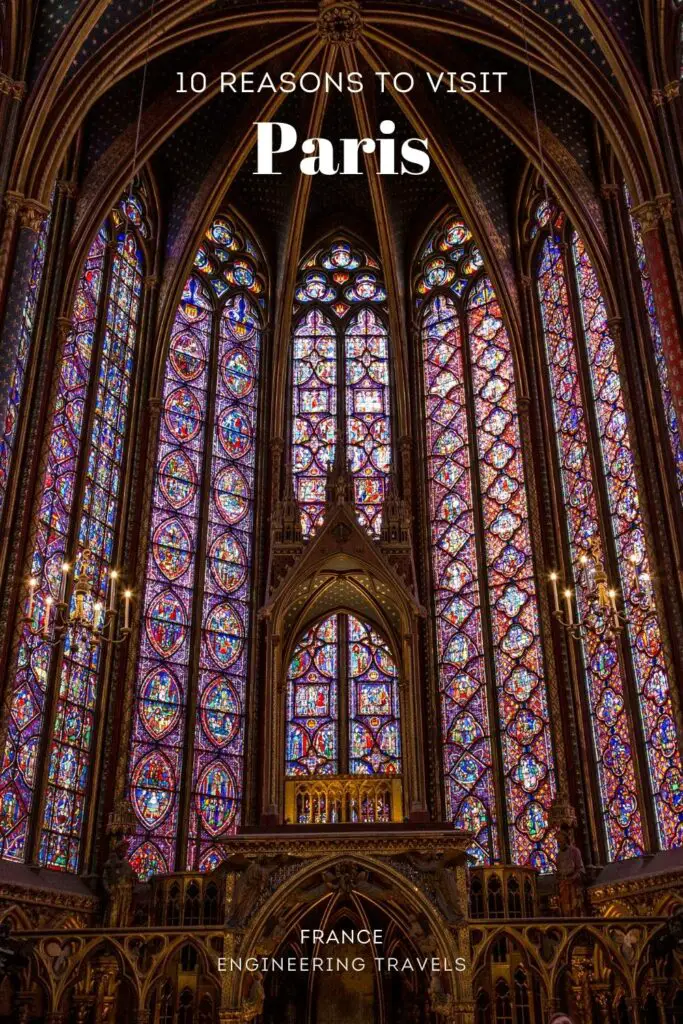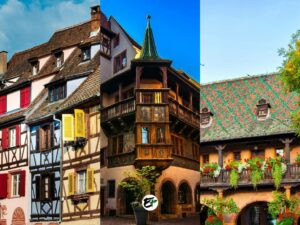10 Stunning Sights in Paris That You Don’t Want to Miss
Paris – the city that tops the travel bucket list of just about everyone we know. It’s the kind of place that friends casually mention they’ll pop over to on their first European escapade. We all have those friends, don’t we?
But let’s be real, even Paris, in all its glory, has its quirks. Some rant about the high costs, the swarm of tourist, and certain corners that might not smell like a bed of roses. These little realities might nudge your expectations a notch down, but does it really overshadow the city’s charm?
If you’re teetering on the edge of a decision to visit Paris, think about the treasures you’d miss if you passed it up. This post is your sneak peek into the heart of Paris, spotlighting the crème de la crème of what the city has to offer. From landmarks that leave you breathless to museums that transport you through time, there’s a whole world within Paris that’s waiting to be discovered.
This post contains affiliate links. I may receive a tiny commission at no additional cost to you.

Use the table of contents to skip to topics.
So, is Paris worth visiting? There’s no need to explain but…
Paris is a city where history whispers from every corner, world-renowned art graces countless walls, and culinary delights are a staple. It promises to satiate your wanderlust, tantalize your palate, and enrich your knowledge, all in one vibrant metropolis! Esteemed publications like CNTraveler and Travel&Leisure echo this sentiment, hailing the French capital as one of the most breathtaking cities you could ever set foot in.
The allure of Paris extends beyond its iconic landmarks. As one of the world’s fashion capitals, it’s not uncommon to spot stylish individuals adding to the city’s chic vibe. And let’s not forget the glittering shopping districts that further enhance the Parisian charm.

Paris, one of the culinary stars of the world, proudly stands second to Tokyo in boasting the most Michelin-starred restaurants. With 10 establishments awarded 3 Michelin stars, 14 with 2 stars, and a whopping 94 with 1 star, Paris is a gastronomic paradise. The city’s French cuisine is a feast for both the eyes and the palate.
If it weren’t for the high cost of living, I’d be packing my bags for Paris in a heartbeat, not to mention city’s iconic café culture! Paris is the undisputed mecca of café life. As someone who relishes the café ambiance for both relaxation and work, I find the hundreds of cafés dotting Paris simply irresistible.
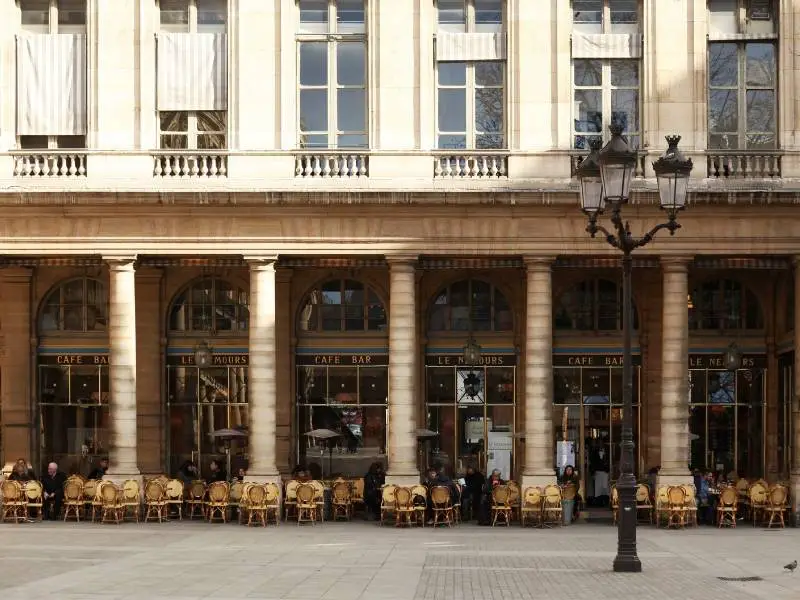
While Paris isn’t the only city known for its vibrant café culture, with Vienna, Granada, and Naples also boasting their own versions, there’s something uniquely captivating about the café life in Paris. Dating back to the 17th century, the Parisian café culture is a living testament to the city’s rich history and the daily rhythms of its inhabitants.
But these cafés are more than just places to enjoy a cup of coffee. They’ve been the creative cradles for some of the world’s greatest talents. Imagine sitting in the same spot where Hemingway penned his thoughts, Sartre contemplated existentialism, or Picasso sketched his masterpieces.
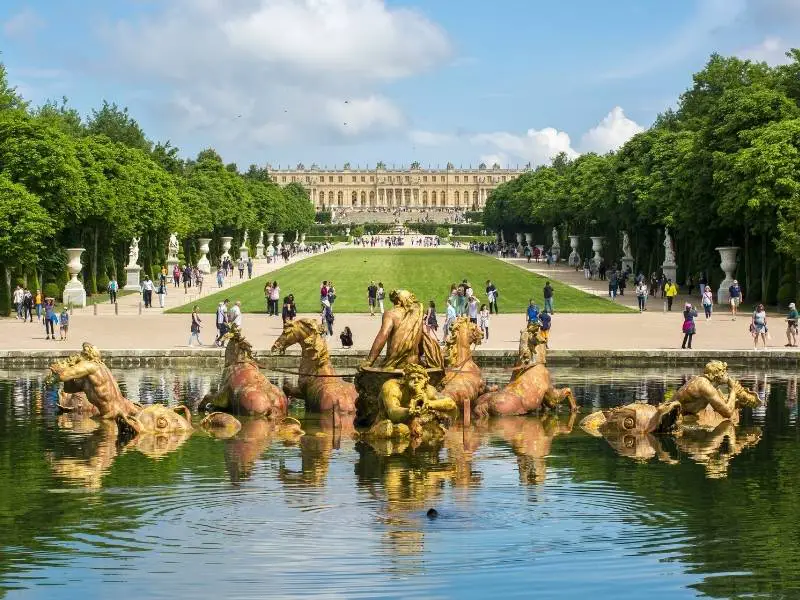
One of the delightful bonuses of a Parisian adventure is the opportunity for day trips beyond the city limits. There’s a world of experiences just a short journey away, with the opulent Versailles Palace and the magical Disneyland being the most renowned. But here’s not so little secret – did you know that London, with all its British charm, is just a roughly 2-hour Eurostar ride away from Paris?
If you are looking for other towns to visit for a day trip from Paris, the three places I recommend you visit are (and here’s why): Reims, Strasbourg, and Colmar.
- Reims — The city where the kings of France had and celebrated their coronation.
- Strasbourg — One of the capital cities of Europe. A place where you can discover different architectural landmarks dating from all ages.
- Colmar — A town where you can satisfy your escapist desires. Its colorful half-timbered houses are straight out of a fairytale.
Indeed, Paris is a city that wears many hats — a hub of culture, a foodie’s paradise, a launchpad for exciting day trips, and a shopper’s dream. But if you ask me, the true heart of Paris lies in its iconic landmarks, museums, and historical sites. These are the treasures that draw millions of visitors to the city each year.
They are the soul of Paris, and exploring them is like stepping into a living history book. So, let’s embark on a journey together through the best attractions Paris has to offer. I’ll be your guide, unveiling the unique value each destination holds. Let’s go!
By the way, if you are staying in Paris, you can find the best hotel deals in Paris here. Here’s a list of deals, skip-the-line tickets, and affordable tours to help you visit these beautiful attractions in Paris without hassle.
1. Eiffel Tower
Paris and the Eiffel Tower – the two are inseparable. A trip to Paris is incomplete without witnessing the majesty of one of the world’s most iconic landmarks. Ever found yourself lost in a daydream, picturing the Eiffel Tower as seen in a movie or on a postcard?
Consider this your nudge towards making that dream a reality. The experience of visiting Paris and standing beneath the towering elegance of the Eiffel Tower is multifaceted. For me, it’s a privilege and a dream come true to see it in person.
As a traveler, there’s an indescribable sense of awe in being in the presence of such an emblematic and historic monument. For some, particularly couples, it’s a romantic aspiration fulfilled. Others seek a tangible connection to history, while many are simply awestruck by this architectural marvel that was truly revolutionary in its time.

The Eiffel Tower, regardless of what it means to each individual, remains the quintessential symbol of France. A trip to France without even a fleeting glimpse of this iconic structure, or let’s be honest, a selfie in front of it, would feel incomplete.
The Eiffel Tower stands as a testament to human ingenuity, a blend of artistic elegance and technological prowess that continues to inspire awe. It’s hard not to feel a thrill at the prospect of visiting such an iconic landmark.
For four decades, the Eiffel Tower held the title of the world’s tallest structure. Although its 324-meter (1063-feet) height is now overshadowed by modern skyscrapers, its charm remains undiminished. The revolutionary architecture of the Eiffel Tower, with its 18 thousand steel parts and 2.5 million rivets, is a sight to behold and a true ‘shutter-presser’ for any visitor.
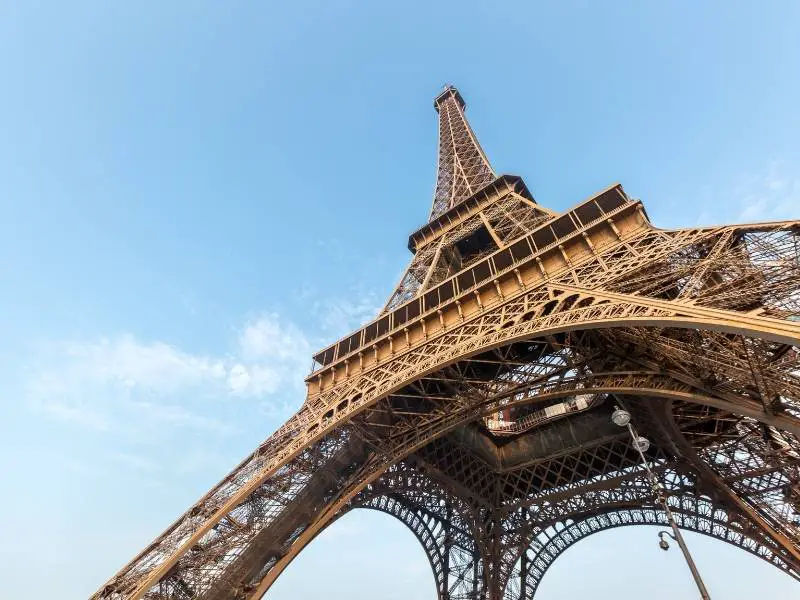
As night falls, the Eiffel Tower transforms into a dazzling spectacle. Illuminated by 20,000 twinkling light bulbs, it mirrors the stars in the Parisian sky and sparks a similar twinkle in the eyes of its admirers. The tower’s elegance is undeniable, whether viewed from the ground during the day or under the night sky.
But did you know that you can ascend this iconic structure? With three floors and an esplanade below, each level offers a unique experience and a glimpse into the tower’s rich history.
In my opinion, the Eiffel Tower should be the first stop for any visitor to Paris. Its floors serve as perfect vantage points for panoramic views of the city, offering an introduction to Paris’s architectural landscape and other landmarks.

Eiffel Tower is open from 11:30 AM to 3:00 PM and from 7:30 PM to 11:00 PM, Monday through Saturday.
Learn all the information you need to know from the official website of the Eiffel Tower.
2. Cathedral Notre-Dame
During my school days, I remember not being particularly fond of history. It felt dry and uninteresting. However, I later realized that it wasn’t history itself that was boring, but the way it was taught to us. Imagine if we could actually visit the places where history unfolded – wouldn’t that make learning so much more exciting?
One of the places on my bucket list is Paris. This city, steeped in over 2000 years of history, is home to numerous monumental structures. Each one tells a story of its own, making the city a living museum.
Take the Eiffel Tower, for example. It’s not just a symbol of Paris, but also a celebration of an important event – the centennial year of the French Revolution. So, visiting historical places like these is not just about sightseeing, but also about experiencing the rich tapestry of history that they represent.
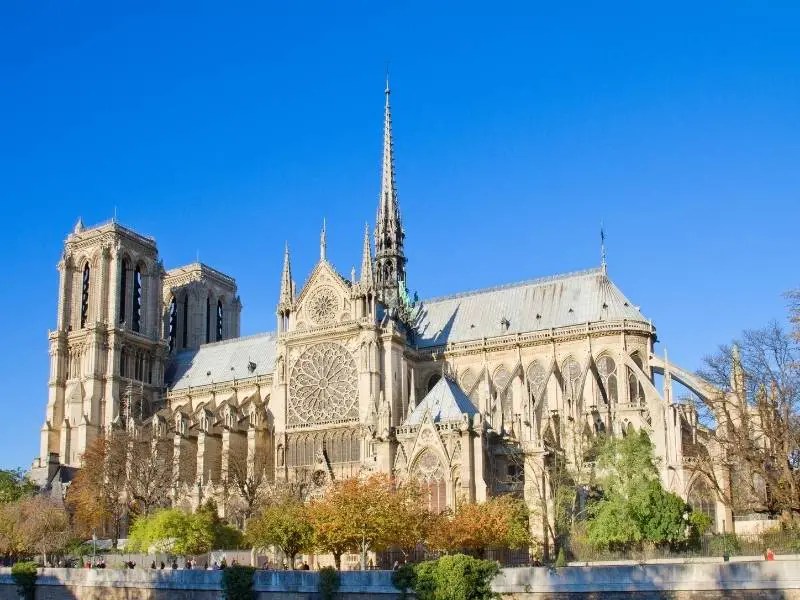
Another gem in the heart of Paris is the iconic Notre-Dame de Paris. This historic church, a masterpiece from the 12th century, stands as a testament to the exquisite Gothic design. But Notre-Dame is not just about its architectural grandeur.Within its hallowed halls, a significant event unfolded in 1804.
Napoleon Bonaparte, in a display of audacious self-assurance, crowned himself as the Emperor of France. So, when you visit Notre-Dame, you’re not just seeing a church; you’re stepping into a page from history. The essence of visiting historical places like the Notre-Dame de Paris is profound.
Historical places are like portals, linking us to the past and broadening our understanding of diverse cultures. They let us imagine past events, offering a unique form of time travel and escapism.

As you stand before Notre Dame, history and fiction intertwine, painting a vivid tableau in your mind. Victor Hugo’s renowned novel, “The Hunchback of Notre Dame,” is one such tale that comes to life. Disney’s animated rendition of this classic offers a window into the heart of the cathedral and a portal into the tapestry of medieval France.
Notre Dame is more than just an inspirational monument steeped in history; it is the architectural masterpiece of Paris. It stands as a paragon of French Gothic architecture, captivating all who lay eyes on it. From its awe-inspiring facade to its towering flying buttresses, from its expansive rose windows to its lofty spire—every aspect of Notre Dame exudes grandeur.
Its magnificent visage compels you to capture its beauty, making it impossible to simply walk away without a photograph. While it may be a figure of speech, Notre Dame’s splendor is indeed a sight to behold and an experience to cherish.

Once a sanctuary for some of the most revered relics in Christendom, Notre Dame de Paris was home to treasures beyond measure. Among them, the Crown of Thorns held a place of prominence. Now, this sacred artifact resides within the hallowed halls of the Louvre, moved there for safekeeping following the tragic fire incident at Notre Dame in 2019.
The flames that engulfed the cathedral left a scar on its historic facade, a poignant reminder of its vulnerability. Restoration efforts are underway, with authorities estimating a timeline of approximately five years to return Notre Dame to its former glory. As such, the cathedral’s doors will remain closed to the public until the summer of 2024.
You may get news and updates about Notre Dame from its official website.
Trivia! Did you know that France was once the center of Christendom? Seven popes resided in Avignon (the world’s largest Gothic palace).
3. Arc de Triomphe
Paris is a canvas painted with architectural masterpieces. The Eiffel Tower and Notre Dame are the stars of the show, but the city’s allure doesn’t stop there. Did you know that the very layout of Paris is a marvel of architectural design? Imagine taking flight and observing the city from above.
You’d see a captivating pattern unfold. Paris is dotted with numerous plazas, each acting as a nexus where several avenues meet, weaving an intricate urban tapestry. Among these, Place Charles de Gaulle is a standout. This grand square is a symbol of the city’s meticulously planned architecture and urban design.
So, when you set foot in Paris, remember to appreciate not just the famous landmarks, but also the intricate design of the city itself.
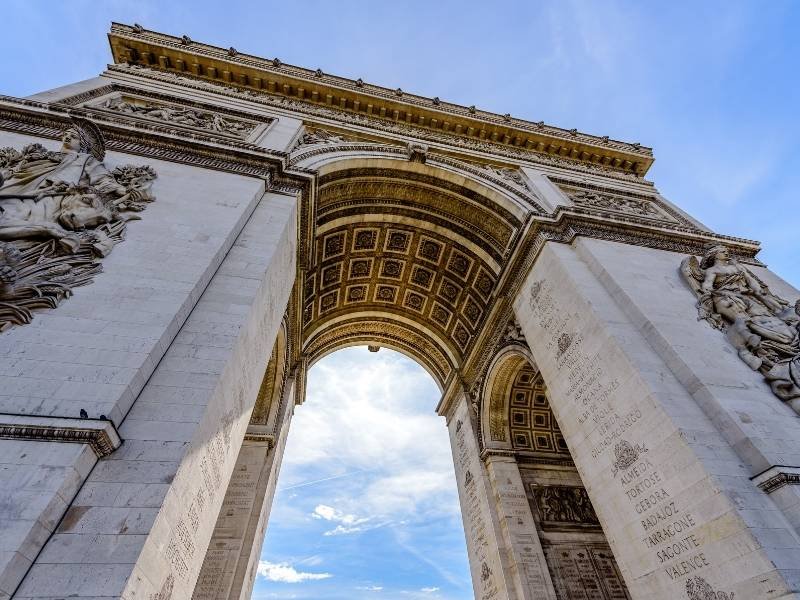
From the dizzying heights of the Eiffel Tower’s top floor, a unique spectacle unfolds before your eyes. If you cast your gaze northward, you’ll spot the distinctive Place Charles de Gaulle. Once known as Place de l’Étoile, or “The Star’s Plaza,” this juncture is a star in its own right.
The plaza is characterized by 12 avenues radiating from its center, creating a star-like pattern that’s easily recognizable from your lofty vantage point. Among these avenues, the Champs-Élysées stands out. Known for its bustling theaters, luxury stores, and charming cafes, it’s a slice of Parisian life that adds to the allure of Place Charles de Gaulle.
But what truly sets this plaza apart is the monument that graces its center, standing as a testament to history and art. So, as you stand atop the Eiffel Tower, take a moment to appreciate this view.

Nestled in the heart of Place Charles de Gaulle stands a monument of monumental significance – the Arc de Triomphe. This colossal arch, erected in honor of French heroes, is a testament to their bravery and sacrifice. The names of those who laid down their lives during the French Revolution and Napoleonic Wars are etched into its stone, a silent tribute to their valor.
While photographs may not do justice to its grandeur, in reality, it’s an awe-inspiring sight! At the time of its inauguration in 1836, it held the title of the world’s largest arch. Standing at an impressive 50 meters tall, this architectural marvel showcases the elegance of neoclassicism.
Its pillars are adorned with intricate relief sculptures, each symbolizing and commemorating different pivotal moments in French history. So, as you stand before the Arc de Triomphe, remember – you’re not just looking at a structure; you’re witnessing a piece of history.

The sculptures and reliefs adorning it hark back to the late 18th and early 19th centuries, each one a testament to the artistic prowess of the era. To say they are impressive would be an understatement. Venture beneath the primary arch of the Arc de Triomphe, and you’ll find even more remarkable decorations waiting to be discovered.
But the experience doesn’t stop there. Like its counterpart, the Eiffel Tower, visitors are invited to ascend the Arc de Triomphe and take in the city from its viewing decks. From this vantage point, you’ll be treated to a breathtaking view of the Eiffel Tower and an expansive panorama of the Parisian cityscape.
The Arc de Triomphe welcomes visitors from 10:00 am until 11:00 pm. You must check the official website of Arc de Triomphe for announcements before making plans to visit.
4. Panthéon
The Panthéon is another Parisian landmark that adds a dash of magic to any visit to the city. This architectural spectacle is not just a historical monument, but a symbol that whispers tales of cultural significance. Its religious nuances add an air of mystery, making it a canvas painted with intriguing discoveries.
While it may not be in the same spotlight as some of the other attractions we’ve journeyed through, the Panthéon’s allure is undeniably captivating. The enriching experience it offers to its visitors is like finding an unexpected gift.
Overflowing with unique elements that add a sprinkle of enchantment to any trip to France, the Panthéon is a chapter in your travel story you wouldn’t want to leave unread.

The Panthéon, a grand structure with a history as rich as its architecture, has stood the test of time since 1790. Initially, it served as a church, dedicated to the Patroness of Paris, Saint Genevieve. However, the winds of the French Revolution swept through its halls, transforming it into a temple devoted to liberty.
But fate had a sense of humor. The Panthéon would once again echo with hymns as it was converted back into a church, only to be turned into a temple yet again. Today, it stands not just as a testament to architectural brilliance but also as the final resting place of important French personalities.
The Panthéon is more than just a mausoleum. For those who find joy in the intricate details of stylish architecture, the Panthéon is a feast for the eyes. Its exterior, modeled after a Greek temple, can leave one in awe.
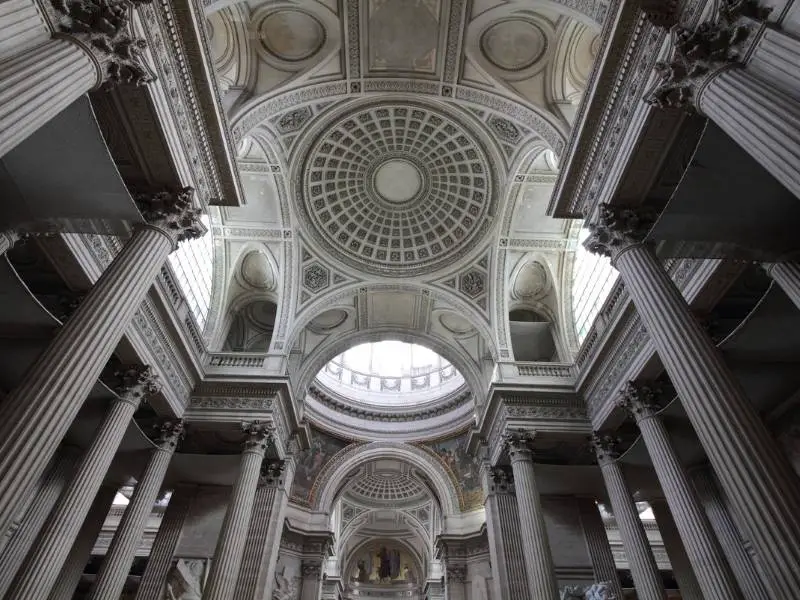
To me, the Panthéon’s pediment is a sight to behold, adorned with magnificent reliefs that depict liberty and honor great French leaders. Etched below these masterpieces is the inscription “Aux grands hommes la patrie reconaissante,” a tribute that translates to “To the great men, from a grateful nation.”
As your gaze ascends, the Panthéon’s dome, designed to rival the grandeur of Saint Peter’s Basilica in the Vatican, captivates your attention. Within its vast expanse, frescoes depicting the Apotheosis of Saint Genevieve come alive, offering an instant insight into French heritage and history.
Venture beneath the peristyle and you’ll find yourself amidst stunning elaborations that cover the ceiling and walls. Each intricate detail is a testament to the craftsmanship and dedication poured into this architectural marvel.

Make your way to the first floor and prepare to be endlessly amazed. The interiors are simply stunning, adorned with beautiful paintings. These artworks bring to life historical scenes from French history, featuring figures like Joan of Arc and Saint Genevieve.
As an engineer, I find myself naturally drawn to technology, regardless of its age. And in my opinion, the most fascinating feature of the Panthéon is the Foucault pendulum. This 67-meter pendulum, located beneath the dome of the Panthéon, was used by Leon Foucault to demonstrate the rotation of the earth.
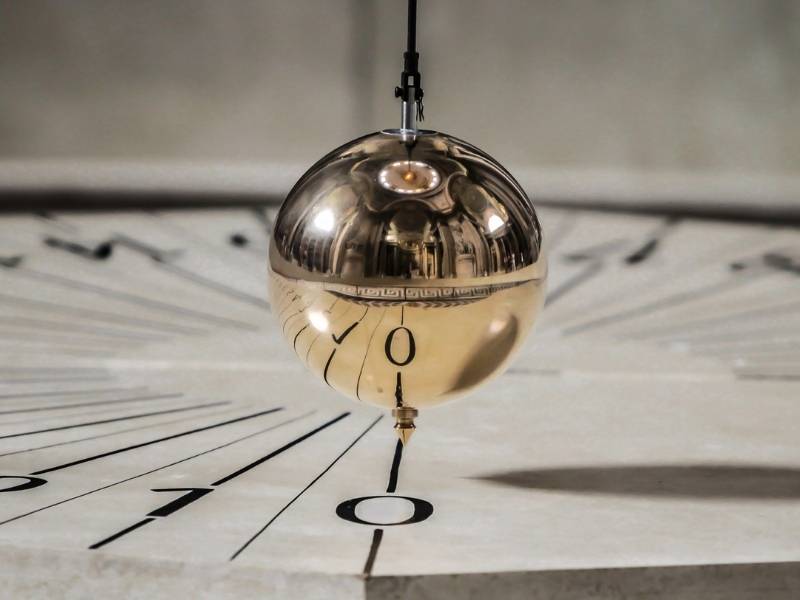
If it is the great people (in their resting place) you want to meet, you must visit the crypt. You’ll find the tomb of Marie Curie, Josephine Baker, and Victor Hugo in it.
Panthéon is open from 10:00 am to 6:00 pm from October 1 to March 31; 10:00 am to 6:30 pm from April 1 to June 30. Visit the official website of the Panthéon to see complete details and announcements.
5. Louvre Museum
Paris is not just a city of historical landmarks, it’s also a city filled with museums that are as picturesque as they are iconic. One such museum is the Louvre — a compelling reason to pack your bags and head to Paris.
There’s a good chance you’ve already seen the Louvre, perhaps on the internet or on social media. And why wouldn’t it be popular? It’s the most visited museum in the world. So, if you’re looking for beauty, history, and a dash of internet fame, the Louvre Museum is waiting for you!
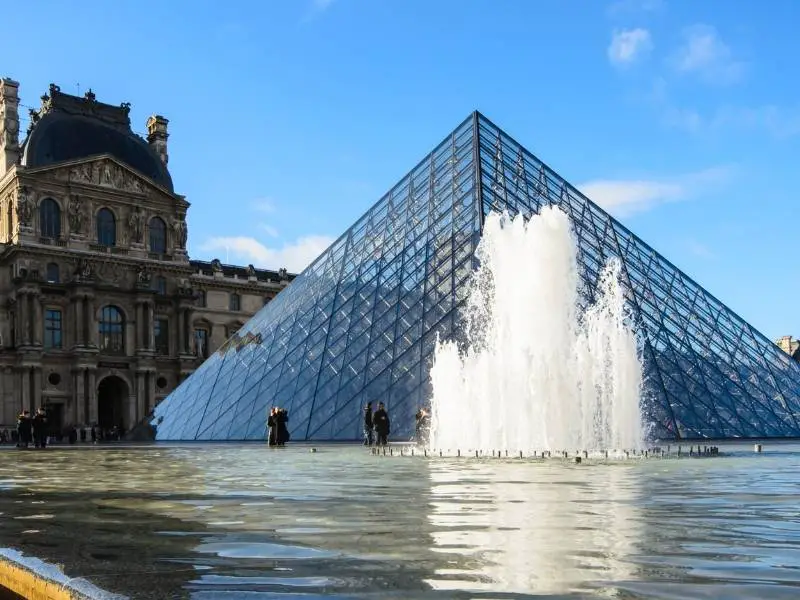
It’s truly astonishing, but the Louvre greets over nine million visitors each year, averaging around 24 to 25 thousand daily. Just envision the massive crowd! (or rather not!) When you see the Louvre from the outside, it’s no wonder why so many people flock to it.
The iconic glass pyramid gracing Napoleon’s courtyard is an absolute must-see. I used to think the pyramid was the entire museum, but I was mistaken! The Louvre Museum is housed within the Louvre Palace, and the glass pyramid serves as its striking main entrance.

Much like the Pantheon, the Louvre offers a tapestry of experiences for its visitors. Beyond its breathtaking architecture and rich historical significance, the true gem lies within its hallowed halls—the world-renowned artworks that grace its galleries. But before we dive into the artistry, did you know that the roots of the Louvre Palace trace back to the 13th century?
It served as the regal residence of French monarchs until the era of Louis XIV in 1682 when he decided to relocate to the opulent Palace of Versailles. When you step inside, prepare to be awestruck by the grandeur of royal chambers and majestic halls that have witnessed centuries of history.
However, the Louvre Palace didn’t fade into obscurity after the kings’ departure; instead, it transformed into a sanctuary for the display of priceless treasures, including exquisite Greek and Roman sculptures. Following the tumultuous period of the French Revolution, it underwent a remarkable evolution, emerging as a beacon of culture—a museum showcasing the nation’s most cherished treasures.
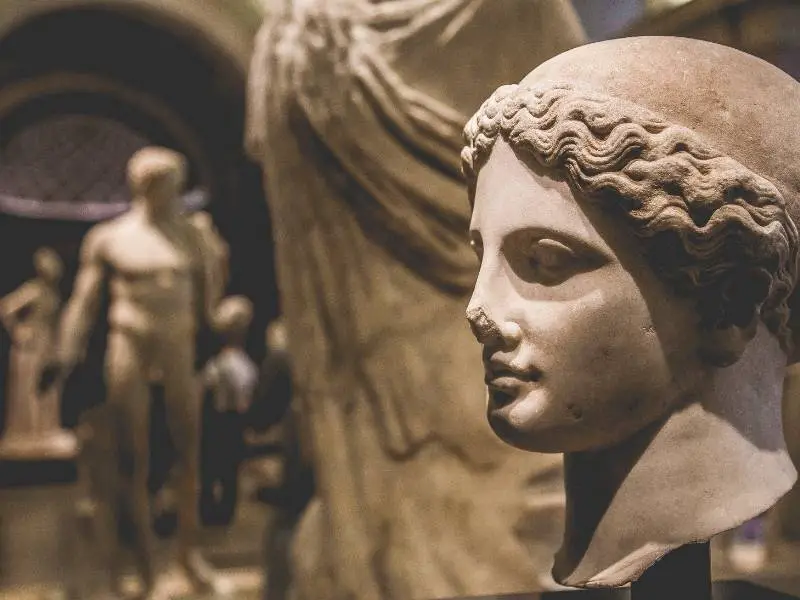
Today, the Louvre boasts an astonishing treasure trove of over 400,000 exhibits, carefully curated across eight distinct departments, comprising roughly 35,000 exquisite artworks.
Within its walls, you’ll encounter a captivating mosaic of artistic expressions, spanning from the mesmerizing strokes of paintings to the timeless beauty of sculptures, from the intricate world of prints to the opulent realm of decorative arts, and beyond.
But what truly sets the Louvre apart is its remarkable inclusivity. Here, you’ll not only find the artistic marvels of Europe but also a captivating journey through the annals of ancient civilizations and the rich tapestry of far-flung cultures.
Marvel at the enigmatic allure of Egyptian relics, immerse yourself in the timeless elegance of Greek and Roman antiquities, and explore the mystique of Etruscan artifacts, all while basking in the splendor of Islamic art.
To navigate this wondrous labyrinth of creativity, the Louvre provides a pre-made visitor’s trail, thoughtfully designed by the museum’s authorities. Along this curated path, you’ll encounter iconic masterpieces, including the world-renowned Mona Lisa, making your visit to Paris an unforgettable voyage through art and history.
Learn more information here.
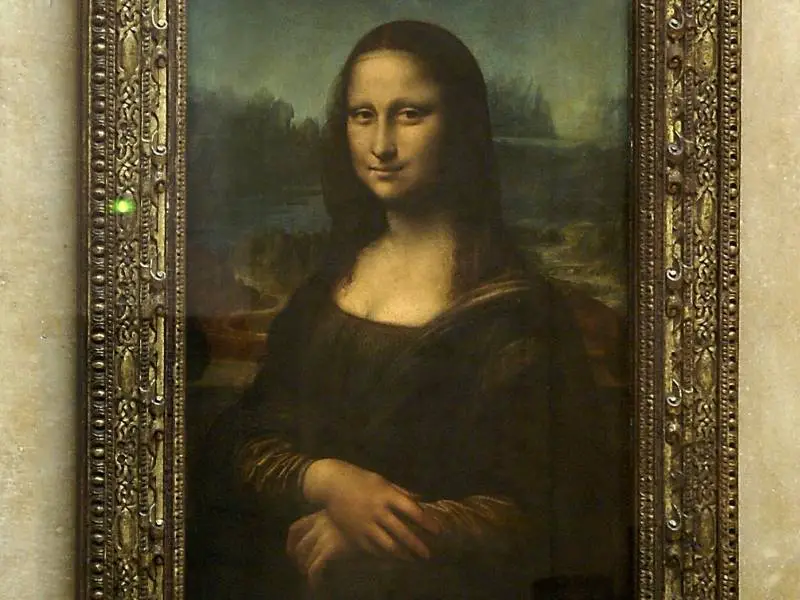
The Louvre is open from Monday, Wednesday to Sunday, from 9:00 am until 6:00 pm. The tickets purchased online cost 17 EUR (15 EUR at the counters). 18 years old below are free to enter. Please check the visitor’s information page for announcements and more details.
6. Musée d’Orsay
One of the aspects I deeply admire about the French is their profound passion for art. It’s a love affair that permeates their very language, which is often described as poetic and enchanting.
In the heart of the French capital, this adoration for art blossoms into an exquisite tapestry of creativity—an undeniable reason to embark on a journey to Paris. Art, in all its forms, serves as a vessel for our emotions, a canvas for our boundless creativity, and a mirror reflecting the depths of our souls.
When we immerse ourselves in art, we bridge the gap between ourselves and the artists who crafted these masterpieces. These works of art have the magical ability to ignite our imagination and stir our emotions, nurturing our humanity in ways that are profound and enduring.

It’s a remarkable phenomenon that occurs when we endeavor to delve into the very essence of an artist’s vision. In these moments, we embark on a journey of self-discovery, forging connections and gaining insights uniquely human.
This quest for a deeper understanding, a yearning to become ‘more human,’ is a profound facet of the Parisian experience.
Paris, adorned with its artistic treasures, offers two exceptional museums where this journey of self-connection through art unfolds. The first, as we explored earlier, is the illustrious Louvre Museum. The second gem is the Musée d’Orsay, an extraordinary place with a history that defies convention.
Like the Louvre, the Musée d’Orsay did not originate as a museum; it was born within the bones of a former train station. Only a few short decades ago, in 1986, did it transform into the cultural sanctuary we know today.
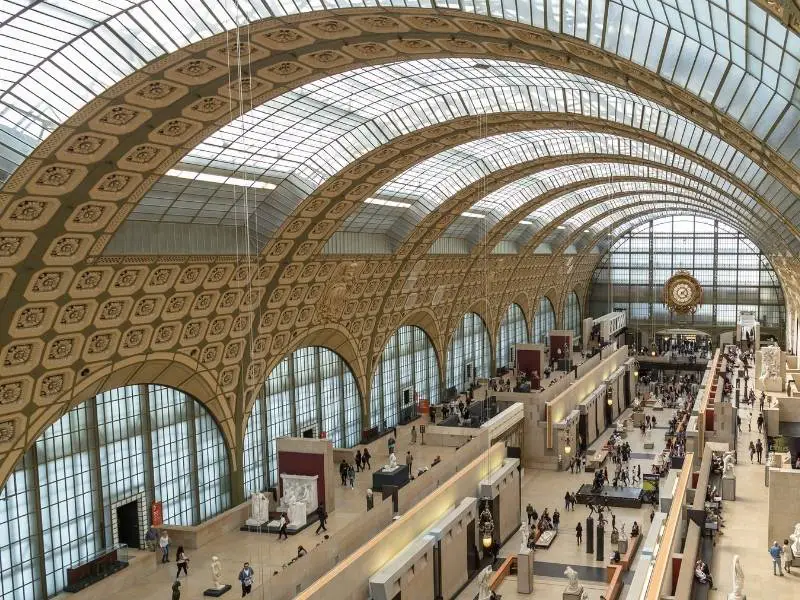
While the Musée d’Orsay may have opened its doors relatively recently, it houses a treasure trove of artworks that transport you back to the late 19th century. But what truly makes Paris an irresistible destination for art enthusiasts is its deep-rooted connection to the very art it exhibits.
Parisians’ profound love for art is not merely passive; it’s transformative. They have left an indelible mark on the art world, giving birth to the revolutionary movement known as Impressionism. Impressionism, led by visionaries like Claude Monet and other Parisian artists, aimed to capture the essence of their contemporary world in their works.
The heartbeat of Impressionism echoed through the streets of Paris, and from there, it radiated across the Western world, leaving an indelible mark on the annals of art history. Today, it stands as one of the most influential and cherished art styles in Western cultural heritage.

If you’re eager to delve deeper into the captivating world of Impressionism and its origins, you can uncover a wealth of knowledge on this artistic movement at history.com. Anyhow, recognizing Impressionist artworks requires no Herculean mental effort. These masterpieces are marked by their distinctive features: the dance of brief brush strokes and the fragmented play of colors that define Impressionism’s unique charm.
Today, Musée d’Orsay proudly reigns as the global epicenter for Impressionist treasures. As the second most-visited museum in France and a revered fifteenth worldwide, it houses around 3,000 artworks, each waiting to enchant and captivate.
Inside, you’ll find the masterworks of iconic Impressionist luminaries like Monet, Manet, Pissarro, Morisot, and Renoir. And even though he hailed from the Netherlands, some of the legendary Vincent van Gogh’s works have found their home within these walls.
If your heart beats to the rhythm of Impressionism, prepare to lose yourself in a day-long reverie of wonder at Musée d’Orsay.

You can discover some of the beautiful artworks in Musée d’Orsay from the museum’s official website.
What should you not miss in Musée d’Orsay? Coquelicots (room 29), La Nuit Étoilée/The Starry Night (room 72), and Olympia (room 14).
Musée d’Orsay is open from Tuesday to Sunday, 9:30 am to 6:00 pm. Open hours extend to 9:45 pm every Thursday. The Entry fee is 16 EUR for adults. Learn more from the visiting information page of Musée d’Orsay’s website.
Do you want to see more museums in France? You should check Lyon. It has fascinating museums and a picturesque historic center.
7. Palais Garnier
As I mentioned before, exploring historical sites is like taking a journey back in time. We encounter settings that breathe life into our wildest daydreams. Paris, in particular, boasts an array of such captivating landmarks, but none quite as unmissable as Palais Garnier.
Step into Palais Garnier, and you’ll find yourself immersed in a world of artistry and opulence. It’s a place that invites you to envision the lavish social gatherings of Paris’s elite from a bygone era. Whether it’s the sumptuous décor, the grandeur of the architecture, or simply the breathtaking spectacle of Palais Garnier itself, it’s an undeniable reason to include Paris in your travel plans.
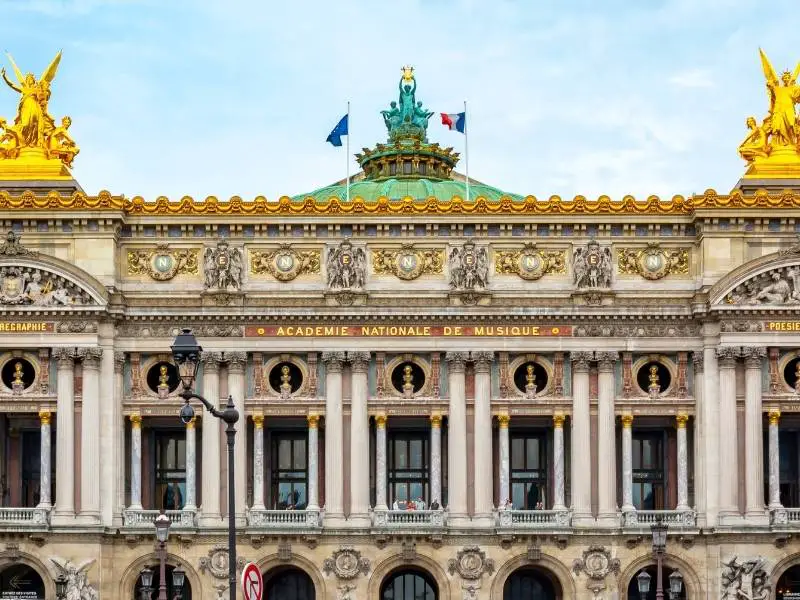
Much like the iconic Eiffel Tower and Notre Dame, Palais Garnier stands proudly as a symbol of Paris. In fact, it holds the distinguished title of being one of the world’s most renowned opera houses. Its architecture is nothing short of a masterpiece, a testament to the highest echelons of artistic brilliance.
It’s no surprise that Palais Garnier has been rightfully deemed a French historical monument.
Located in the heart of the 9th arrondissement, Palais Garnier is an awe-inspiring sight to behold. Its architecture, rooted in the Napoleon III style, seamlessly weaves together various traditional elements. As you wander through its halls, you’ll witness a harmonious blend of Baroque, Renaissance, and Palladio Classicism styles.
From the grandeur of its facade to the intricacies within, Palais Garnier offers visitors a glimpse into architectural magnificence at its finest.
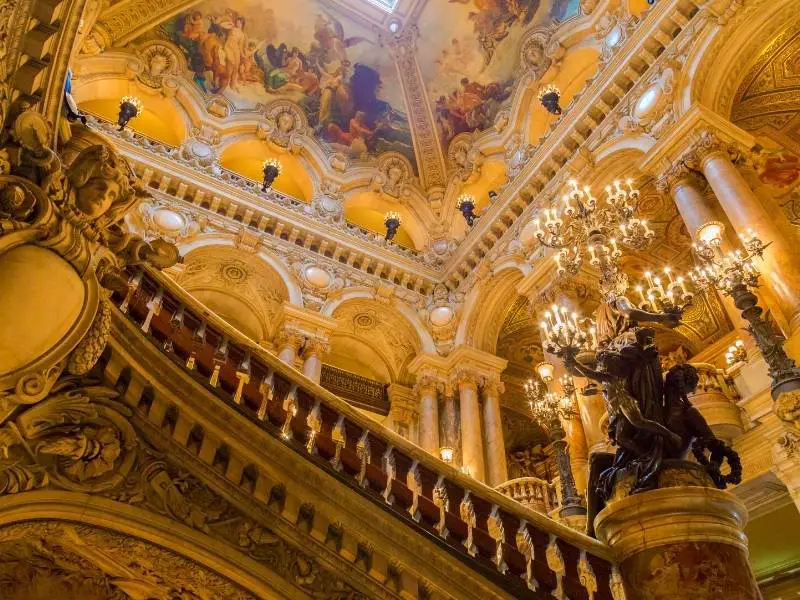
When it comes to Palais Garnier, there are four absolutely breathtaking features that stand out to me. First and foremost, the principal facade, facing south, is a true masterpiece. Adorned with sculptures depicting various art forms, such as music, drama, and dance, it exudes elegance and symbolism.
Notably, the two golden statues atop the facade symbolize harmony and poetry, adding a touch of enchantment to the exterior.
But the real magic lies within the building itself, where you’ll discover three more awe-inspiring elements. The grand staircase, a true architectural gem, beckons you with its grandeur. The grand foyer, resplendent with opulence, invites you to bask in its golden and shimmering beauty.
And finally, the auditorium, where artistic performances come to life in a setting that is nothing short of magnificent. Visiting Palais Garnier is an experience you won’t soon forget, especially when you step inside and are enveloped by its lavishness and the golden, sparkling ambiance that awaits you.
It’s yet another compelling reason to make Paris a destination on your travel itinerary.

Let’s take a mesmerizing journey starting from Palais Garnier’s grand staircase. Crafted to leave a lasting impression, this staircase boasts a stunning combination of white, green, and red marble, creating a visual spectacle that welcomes visitors.
The staircase’s pedestals, adorned with female torchères, exude an inviting aura, setting the tone for the elegance that permeates the entire space. Elaborate Corinthian columns grace the arches, adding to the grandeur.
As you ascend, your eyes are drawn to the captivating frescoes above, depicting Olympian gods, music, and the essence of Paris itself. Guests must tread carefully, ensuring they don’t miss a single detail of these eye-catching artworks.
However, the real magic happens as you reach the pinnacle of the staircase – the grand foyer. Brace yourself for a jaw-dropping moment as you step into this opulent space. The entire hall is enveloped in a golden shimmer, leaving no corner untouched by the brilliance of its embellishments.
Every inch, even the seemingly empty air, is adorned with intricate decorations. Glamorous chandeliers hang beneath the frescoes, casting a radiant glow that adds to the hall’s allure. It’s an experience that transcends ordinary beauty, leaving visitors in awe of the sheer magnificence that defines Palais Garnier’s grand foyer.

A leisurely stroll through the foyer is like taking a musical journey, thanks to the captivating paintings adorning the ceiling. The lyre-shaped decorations above the portals infuse an enchanting vibe, making it an unmissable experience—a compelling reason to explore the enchanting city of Paris.
Of course, the pièce de résistance at Palais Garnier is the awe-inspiring auditorium, which hosts not only grand performances but also holds a fascinating distinction. Did you know that Palais Garnier boasts the “largest” stage in all of Europe?
This colossal stage can accommodate a staggering 450 artists performing simultaneously, a testament to its sheer magnitude. The circles and galleries, with their imposing architectural grandeur, add to the overall splendor.
However, what truly captured my imagination was the monumental chandelier that graces the center of it all. Believe it or not, this magnificent fixture weighs a staggering seven tons, adorned with hundreds of shimmering crystals and radiant bulb lights. During its creation, this masterpiece commanded a value of up to 30,000 gold Francs.
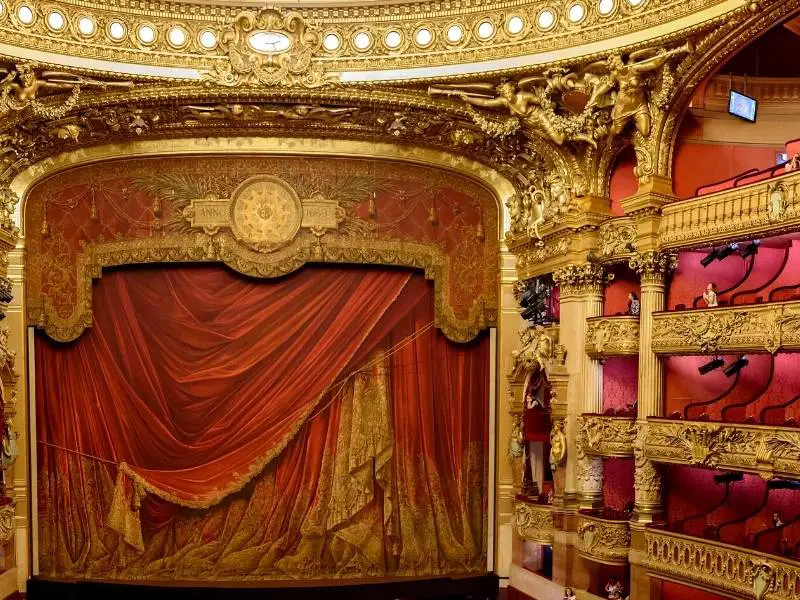
Palais Garnier is open from 10:00 am until 5:00 pm. But, you must come at least 45 minutes before closing time. Learn all the visiting information from the official website of Palais Garnier.
8. Sainte-Chapelle
In my view, the allure of Paris lies in its rich cultural heritage sites, each a masterpiece blending impressive aesthetics with profound historical and religious significance. These sites not only captivate the eye but also feed the wanderlust of travelers, offering glimpses into the deep religious devotion of the French people.
Take, for instance, Sainte-Chapelle in Palais de la Cité, a gem that mirrors the awe-inspiring grandeur of the Sistine Chapel in the Vatican City.
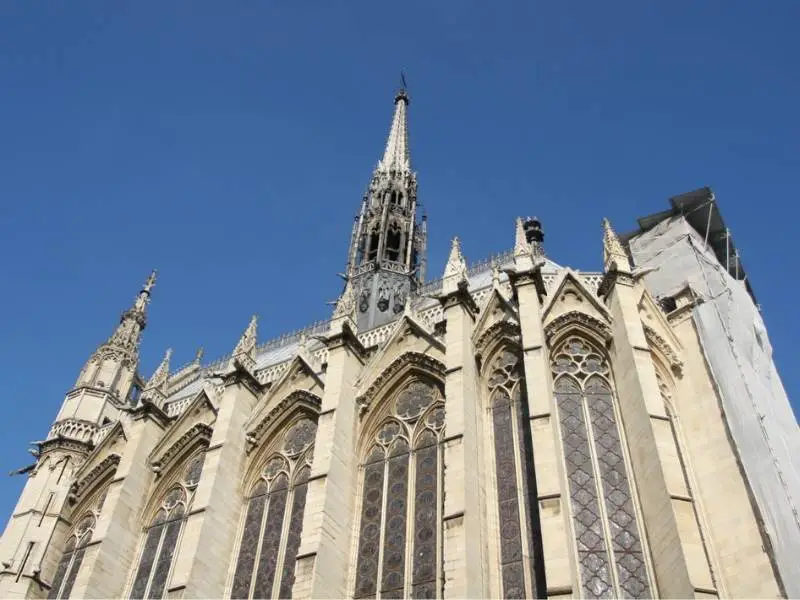
Imagine you’re on a quest to discover Europe’s most exquisite Gothic masterpiece. Well, your search might just conclude at Sainte-Chapelle.
Why, you ask? Because it stands as a pinnacle of the Rayonnant era of Gothic architecture. What awaits within Sainte-Chapelle is a beauty that defies description. Interestingly, this gem of Gothic design traces its origins to the mid-13th century, bearing witness to the might of the French Monarchy of yore.
Naturally, its exterior hints at its splendor, but there’s much more to uncover.
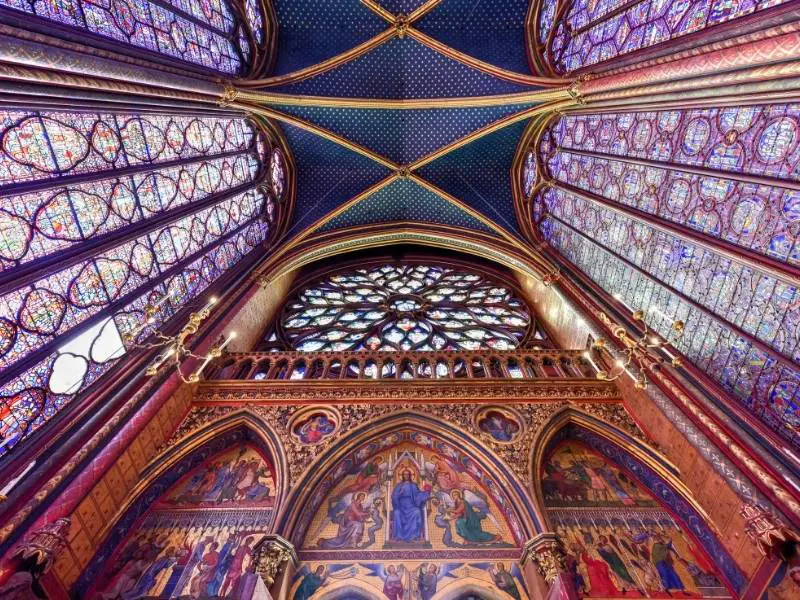
So, How? Sainte-Chapelle’s significance lies in its guardianship of some of Christianity’s most cherished relics, including the Crown of Thorns worn by Jesus. These precious artifacts, acquired at great cost, serve as a testament to the immense influence of the French kingdom. Among the treasures once housed here were the Holy Lance and a fragment of the True Cross.
While Sainte-Chapelle no longer holds these treasures today, its fame endures. In my view, this enduring renown is owed to the breathtaking medieval stained glass windows adorning the upper chapel. They inspire awe like nothing else in our contemporary world.
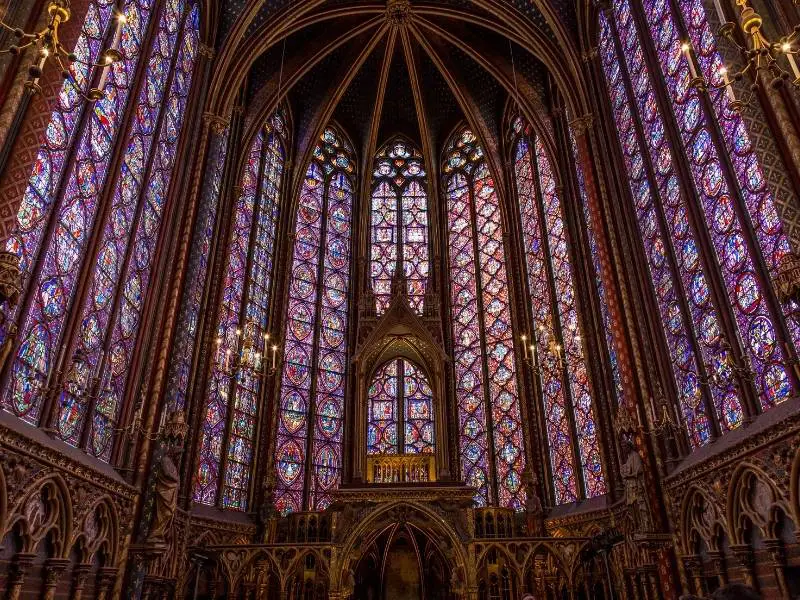
Sainte-Chapelle features two levels: the upper and lower chapels. What truly steals the show, though, is the remarkable stained glass that graces the upper chapel’s walls, towering at an impressive 15 meters in height. Especially on a radiant, sunlit day, stepping inside the chapel treats you to a vibrant explosion of colors.
Picture yourself standing right in the heart of the chapel at that moment—it’s akin to wandering inside a colossal kaleidoscope. These stained glass windows are nothing short of artistic marvels, a monumental masterpiece in their own right. Within their panels, you’ll encounter a multitude of glass panes, each narrating over a thousand biblical scenes.
Missing this spectacle during a visit to Paris would indeed feel like a missed opportunity.
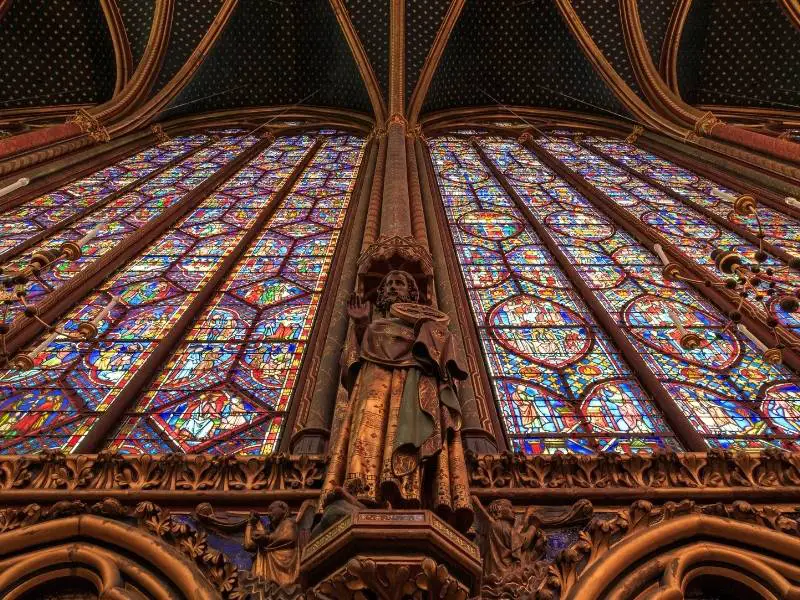
While the upper chapel of Sainte-Chapelle leaves a lasting impression with its stunning stained glass windows, the lower chapel captivates with its intricate vaulted ceiling. Here’s a fun tidbit: the lower chapel boasts a grand total of one hundred and forty columns.
If you’re planning a visit, I highly recommend downloading the Smartphone App of Sainte-Chapelle—it’s a fantastic aid for uncovering the names and hidden gems within this beautiful location.
Be sure to check out the visitor’s information page on Sainte-Chapelle’s website before your trip. I strongly advise booking in advance, especially during peak seasons. The entry fee for adults is 11.5 EUR, and here’s a quick overview of the chapel’s opening hours:
- From April 1 to September 30, 9:00 am to 7:00 pm
- From October 1 and the rest of the year, 9:00 am to 5:00 pm
- Come 45 minutes before closing time.
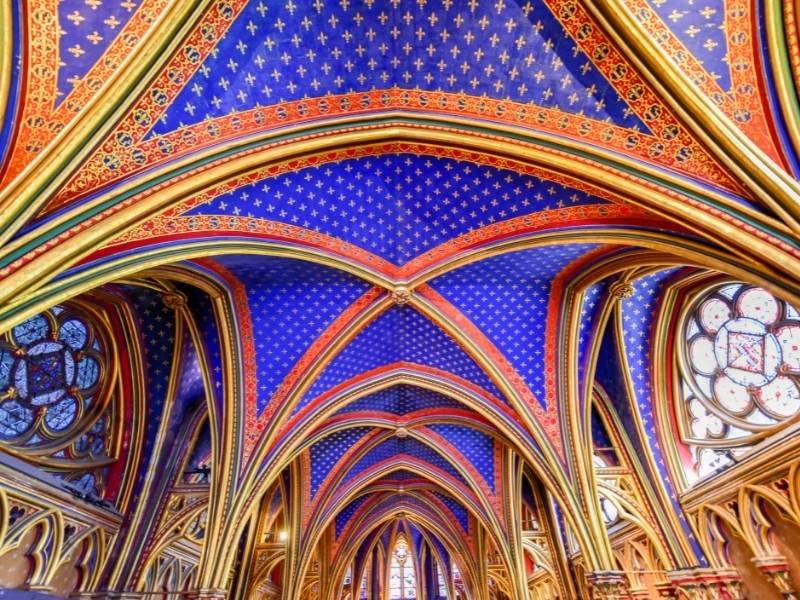
Did you know that it’s in Reims‘ Notre Dame Basilica where the kings of France were crowned? Like Sainte-Chapelle, it has beautiful architecture. Perhaps, it’s more beautiful than Paris’ Notre Dame Cathedral.
9. Luxembourg Gardens
Paris becomes an even more enticing destination thanks to its enchanting green spaces scattered throughout the city. Now, you might think, “Sure, other cities have parks too.” But hold on, these are no ordinary parks; they are splendid gardens. In these lush oases, you’ll encounter more than just trees, playgrounds, and ponds.
Some of Paris’s gardens trace their origins back to the Age of Enlightenment, offering visitors a glimpse of French cultural heritage as they stroll and unwind. Others boast iconic landmarks nearby, providing a multitude of picturesque settings to explore.

For example, the Eiffel tower has parks all around it. You can find a lovely garden in front of the Louvre also! But, if you inquire about the most “unique” park in Paris, it unquestionably leads us to the Luxembourg Garden.
This green oasis has a rich history dating back to the early 17th century. It all began when Marie of Medicis, the widowed queen of King Henry IV, decided to acquire l’hôtel de Luxembourg. Her inspiration came from the breathtaking Pitti Palace and Boboli Gardens she had admired during her visit to Florence.
Enchanted by these splendid places, she yearned for her own palace and garden akin to them, thus giving birth to the exquisite Luxembourg Palace and Garden.
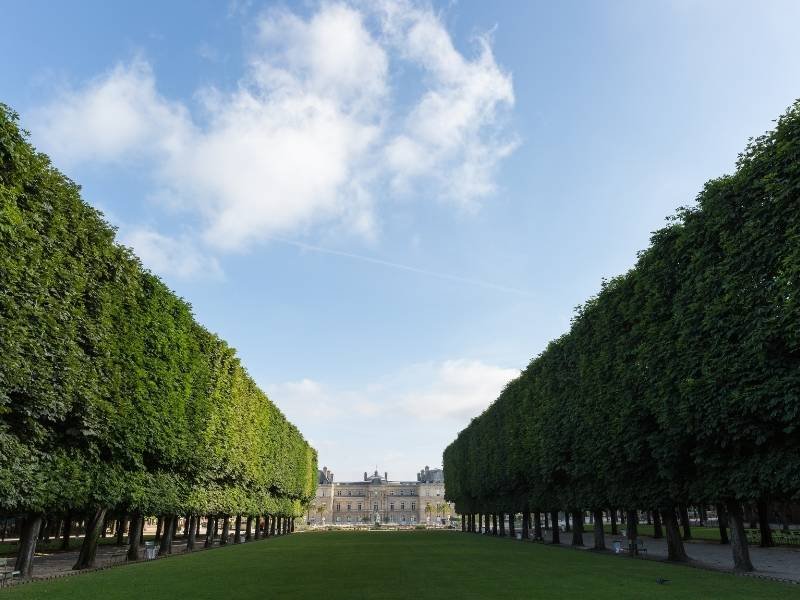
Today, the Luxembourg Palace serves as the home of the French Senate, while its garden has become a cherished leisure destination for people. A visit to this garden offers a delightful glimpse into the daily lives of Parisians, making it a must-see attraction.
But that’s not all; the Luxembourg Garden can be likened to an open-air sculpture museum. Its development spanned decades, resulting in a tapestry of diverse garden styles that visitors can explore.
However, the crown jewel is unquestionably the front estate of the Luxembourg Palace. Here, an octagonal pond graces the landscape, surrounded by lush lawns adorned with vibrant flowering plants. Sitting on the benches facing the palace near the pond, you’ll be treated to a view that’s nothing short of enchanting.
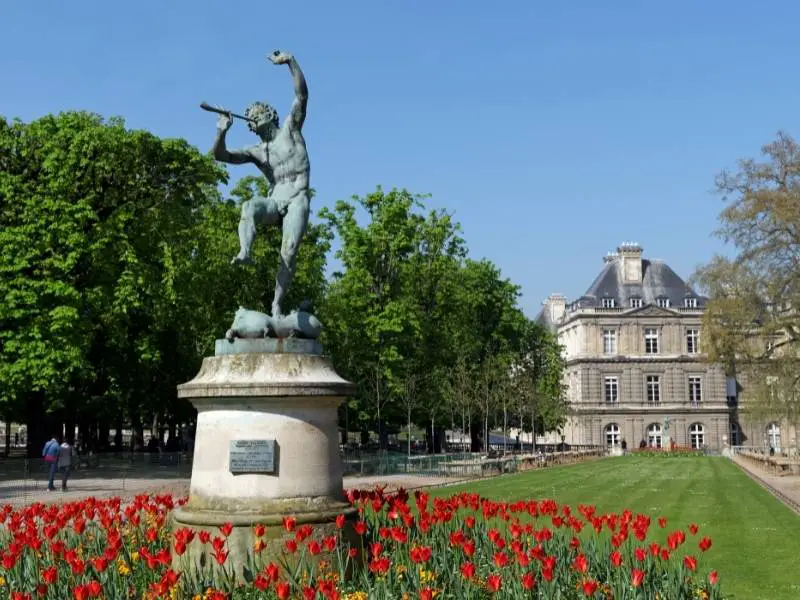
Here’s a fascinating tidbit: Victor Hugo’s renowned novel, “Les Misérables,” unfolds within the captivating setting of the Luxembourg Gardens. It’s where Marius Pontmercy and Cosette have their fateful encounter.
As you stroll amidst the garden’s medieval-inspired statues, it’s easy to envision these characters coming to life in this picturesque setting. Speaking of sculptures, did you know that the original model for the Statue of Liberty, with its full name “Liberty Enlightening the World,” can be found right here in the Luxembourg Gardens?
That’s right! This park boasts more than a hundred statues in total. In the heart of the garden’s green expanse, you’ll discover statues honoring the French queens and renowned women of the country.

Venture to the southwest corner of the Luxembourg Garden, and you’ll stumble upon even more delightful surprises. Here, nestled within an enchanting apple and pear orchard, you’ll discover a charming puppet theater. If you’re traveling with kids, this is a must-visit spot.
They’ll be absolutely thrilled by the puppet shows, and all it takes is less than 7 EUR to treat your family to a full hour of marionette entertainment. But that’s not all—the Luxembourg Garden also boasts some captivating fountains!
If there’s one fountain you simply cannot miss, it’s the Fountain of Medici. This impressive feature stretches along a long basin, adorned with exquisite sculptures of Polyphemus, Acis, and Galatea at its far end.
10. Center Pompidou
As time marched on, Paris continued to evolve, but its unwavering passion for art remained constant. In fact, Paris spearheaded yet another artistic revolution, reaffirming its position as a cultural and artistic hub.
The Center Pompidou, a bold art complex born in the 1970s, stands as a testament to this cultural resurgence. Nestled in the heart of the 4th arrondissement of Paris, it’s a place that’s impossible to miss, thanks to its distinctive post-modern, high-tech architectural style. Without a doubt, it’s a landmark that commands attention and admiration.

In stark contrast to the majority of landmarks and attractions in Paris, the Center Pompidou presents a strikingly modern visage against the cityscape. Its “inside-out” design is remarkably unconventional, marking it as the first building to embrace such a structural system.
This bold departure from tradition exposes the mechanical systems of the building to the outside world, revealing pipes, metal frames, and more. While I may not personally lean towards this modern aesthetic, it undeniably adds a unique twist to every visitor’s Parisian journey.
However, the architectural innovation of the art complex is just one facet that makes the Center Pompidou a must-see in Paris.
What truly sets it apart, particularly for creative souls and art enthusiasts, is the role it plays. Designed as a melting pot for a diverse range of art and literature, it stands as a compelling testament to the city’s artistic spirit. This is why you can find more than one entity in the Center Pompidou.
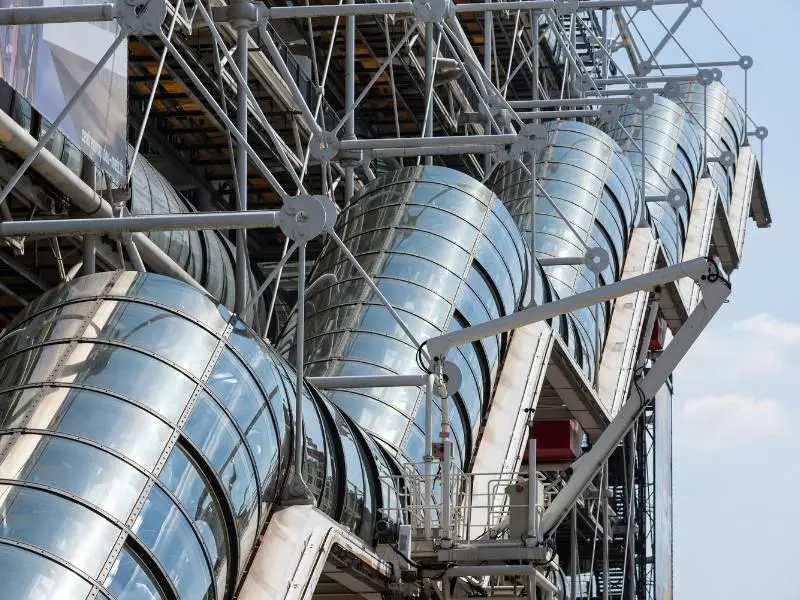
Within this complex, you’ll find a treasure trove of cultural gems. It houses the expansive Public Information Library, IRCAM (the center for music and acoustic research), and most notably, the Musée National d’Art Moderne—the largest museum of contemporary art in Europe.
The creative energy of the Center Pompidou spills over into Place Georges Pompidou, the vibrant square just in front of the museum. Here, you’ll encounter a colorful cast of street performers eager to delight visitors, including bands, sketch artists, skateboarders, and even mimes and jugglers.
Attempting to detail every artwork and masterpiece within the Center Pompidou would be an endeavor in itself. In essence, it boasts an astonishing array of collections, spanning from drawings to visual arts, photography to industrial design.
And that’s not all; it also features architectural works, film, and new media, creating a rich tapestry of artistic expression waiting to be explored.
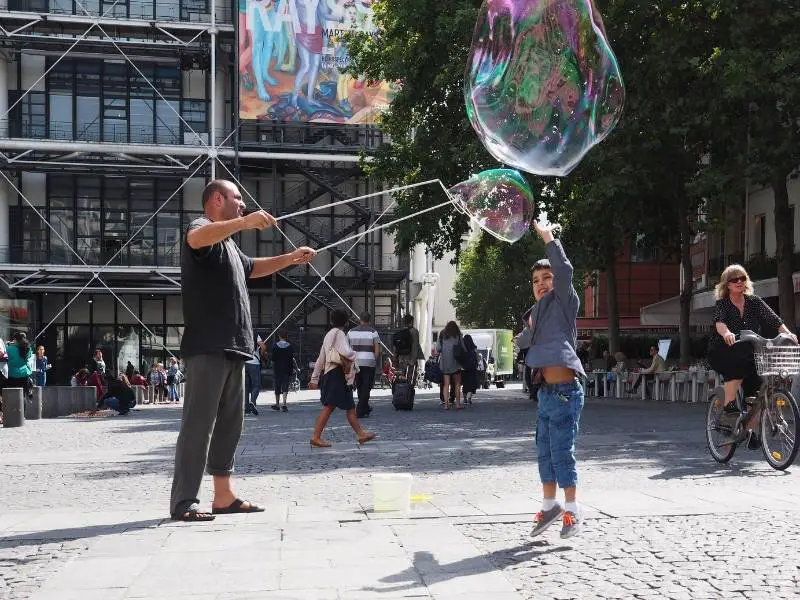
Contemporary art often departs from the immediate awe-inspiring impact of medieval and Renaissance works. Instead, it tends to engage our minds, urging us to ponder the artist’s message and prompting a different, often ineffable experience.
For instance, Marcel Duchamp’s “Fontaine,” tucked away in room 19 on the 5th floor. It’s essentially a urinal bearing the artist’s signature—a piece that has sparked considerable controversy.
Yet, as is characteristic of contemporary art, it invites us to contemplate its meaning on multiple levels. Of course, not all contemporary artworks appear entirely devoid of artistic essence. Some, like “Le Magasin de Ben,” are replete with intricate details, featuring an assortment of random objects adorned with written words in various fonts.
Others, like Yaacov Agam’s “Layout of the antechamber to the private apartments at the Elysée for President Georges Pompidou,” are strikingly Instagrammable, employing Agam’s principles of “polymorphic imagery” to captivate the viewer’s attention in a unique way.

Center Pompidou is open every day except Tuesday. It starts accepting visitors from 11:00 am until 10:00 pm, and the regular tickets cost 14 EUR. See all visitors’ information from the website of Center Pompidou.
Guides In Visiting Paris
They often say that Paris is a lovely destination. Here’s to hoping that my presentation of these 10 captivating attractions has not only piqued your curiosity but also ignited the spark of wanderlust within you.
If you’re now contemplating a Parisian journey, allow me to extend a friendly suggestion: consider exploring the city with the aid of some expert guides and immersive tours (check out the options below).
My deepest wish is that you uncover the true essence of travel and unearth the hidden “travel gems” that this extraordinary city holds.
When To Visit Paris
As you map out your Parisian adventure, take a moment to ponder your inclinations regarding crowds, weather, expenses, and local happenings. This thoughtful consideration will pave the way for an extraordinary experience in this captivating city.
Remember, the timing of your visit holds the power to shape your Parisian journey in remarkable ways. Nevertheless, Paris is an all year destination.
Looking for the best time to visit Paris without the crowds?
The city is busiest from May to September, with July being the peak month. If you want a more peaceful experience, think about visiting between October and April. Specifically, mid-January through mid-March and mid-September through mid-October are ideal times to visit Paris and other attractions outside the city like Disneyland.
Searching for the golden window to enjoy Paris without emptying your wallet?
Well, Paris can be a bit heavy on the pocket, especially during its peak season. The savvy choice for budget-conscious travelers is the off-season, encompassing the frosty months of early December, January, and February. Yes, the chilly winters may nip at your nose, but they also bring more budget-friendly options to the table.
Now, about those times when Paris might not be at its absolute best—let’s chat about that.
While there’s never a truly “bad” time to explore the City of Light, some periods come with their quirks. Picture sweltering summers from June to August, with heatwaves that might not make outdoor escapades the coziest. Furthermore, these months happen to be the peak of the tourist surge, which translates to crowded attractions and heftier accommodation bills.
Keep an eye out for August, as it can bring its own set of challenges, with certain attractions and establishments opting for their summer break.
Lastly, Visiting Paris during an event can be a great idea! Events often bring a unique atmosphere to the city, and you can experience something different from the usual tourist attractions.
Here’s the calendar of events to help you discover different events in Paris.
How Long To Stay In Paris
How many days should you spend in this enchanting city? Let’s break it down based on different travel preferences.
If you find yourself pressed for time but still eager to see the highlights of Paris, a whirlwind tour of the city’s crown jewels like the Eiffel Tower, the Louvre, and the Arc de Triomphe can be squeezed into a busy two-day itinerary.
For a more fulfilling experience that allows you to immerse yourself in the nuances of this enchanting metropolis while still visiting the iconic sites, it’s often advisable to set aside three days. This extra day not only offers a more relaxed pace but also grants you the opportunity to wander through charming districts, indulge in delectable pastries at local cafes, and savor the true essence of Parisian life.
If you’re eager to explore all that Paris has to offer, from its renowned museums to its delightful neighborhoods, it’s advisable to allocate a minimum of four or five days. Let’s say you’re looking to see all the beautiful places on my Paris list. Then you’re going to need about 4 to 5 days.
Let me break it down for you. Each attraction is going to take a certain amount of time to really take in. When you add up all those hours, plus time for meals and getting from one place to another, you’re looking at a solid 4 to 5 days:
- For the Eiffel Tower, you should plan for at least 1 1/2 hours if you’re visiting the 1st and 2nd floors, and 2 1/2 hours if you’re going to the top.
- A visit to the Notre Dame Cathedral typically takes about an hour, as does a visit to the Arc de Triomphe.
- The Pantheon can be explored in about 30 minutes to an hour.
- The Louvre Museum, home to thousands of works of art, requires at least 4 hours for a thorough visit.
- The Musée d’Orsay, known for its collection of Impressionist and Post-Impressionist masterpieces, can take between 2 to 4 hours.
- A guided tour of the Palais Garnier, one of the most famous opera houses in the world, takes about 90 minutes.
- The Saint Chapelle, known for its stunning stained glass windows, can be visited in about 30 minutes to an hour.
- The Luxembourg Gardens are a perfect place to relax and can be enjoyed in about 2-3 hours.
- Lastly, a visit to the Centre Pompidou, a modern art museum with a unique architectural design, can range from 1 hour 30 minutes to 2 hours 30 minutes.
When it comes to budget travel, the length of your stay in Paris can be quite flexible, contingent upon your daily spending habits.
If you’re keeping a close eye on your wallet, you can make your euros stretch over the course of about a week in this captivating city with a budget of around €700 for budget-type accommodation + a few more hundred Euros for food and entry ticket prices.
How To Get Around Paris
You’ve got plenty of options to explore Paris.
The Metro, which is their subway system, is a quick and cost-effective way to get around. It covers most of the city and you can get a ticket for a single ride, a day, or even a week. Buses are also available, but they might not be as fast or cover as many areas as the Metro. Trains are another great option in some areas.
If you’re in a hurry or prefer a more private mode of transportation, cabs are available, although they can be a bit pricier.
Paris is also a great city to explore on foot. It’s pretty compact, so walking combined with public transportation can be a good way to see the sights.
For those who enjoy cycling, Paris has electric bicycle stations all over the city. They’re called Velib. And let’s not forget about the boats! You can take a sightseeing boat along the Seine River and hop on and off at each stop.
Please check the official website of Paris for more information about getting around Paris.
Where To Stay In Paris
Paris has many neighborhoods, each with its own charm and character. To help you decide, here are the top 3 neighborhoods for tourists, with their pros and cons.
Here’s where you can find the best hotel deals in Paris.
-
Louvre/Tuileries, 1st Arrondissement
- Pros: This is the perfect location for sightseeing, as it’s close to the famous Louvre museum and the beautiful Tuileries Garden. You’ll also enjoy easy access to other parts of Paris by public transportation. The area has a lot of history and culture, giving you a taste of the Parisian lifestyle.
- Cons: This area can get very crowded with tourists, especially near the Louvre. You might have to deal with long lines and limited availability for guided tours. The area is also very expensive, so expect to pay more for dining and shopping.
-
Les Halles, 1st & 2nd Districts
- Pros: Les Halles is in the heart of Paris and has a lively atmosphere. It’s near many attractions and well-connected by public transportation.
- Cons: Some people might feel unsafe in this area, especially at night. However, others say that it’s no more dangerous than any other part of the city. The area can be noisy and busy with young people, especially on weekends.
-
Champs Élysées / Golden Triangle, 8th Arrondissement
- Pros: This is the area for luxury and glamour, with many high-end boutiques and restaurants. It’s also home to the famous Champs-Élysées avenue and close to several tourist attractions.
- Cons: This is one of the most expensive areas in Paris, so you’ll have to pay a premium for accommodation. It’s also not very residential, as it’s mostly occupied by businesses and luxury shops
More Beautiful Destinations in France (Aside from Paris)
If I were to wholeheartedly recommend a place in France time and time again, it would undoubtedly be the South of France.
To me, it stands out as the most enchanting region in the country. Its landscapes are a mesmerizing blend of breathtaking natural beauty, charming villages frozen in time, and rich historical sites. And here’s the beauty of it—despite the South of France being hundreds of kilometers away from Paris, reaching this idyllic destination is a breeze.
Some cities and towns, such as Annecy, Lyon and Avignon, are just a single train ride away, with a travel time of approximately 3 to 4 hours. Once you’ve arrived in the South of France, you’re just a stone’s throw away from some of the region’s most picturesque villages, which you can explore below.
- Gordes — a stunning stone village that sits on a hilltop overlooking the Luberon valley. You’ll love its architecture and scenery.
- Eze — a medieval village that offers breathtaking views of the Mediterranean Sea from its exotic garden and castle. You’ll feel like you’re in a fairy tale.
- Rocamadour — a sacred village that has a rich religious heritage. You’ll be amazed by its chapel with a black Madonna and its basilica with a golden reliquary.
- Moustiers-Sainte-Marie — a charming village that is famous for its faience pottery. You’ll enjoy its waterfalls and its star that hangs between two cliffs.
- Aigues-Mortes — a fortified village that has impressive city walls. You’ll witness its salt marshes and taste its local specialties.
- Carcassonne — a medieval citadel that was restored by Viollet-le-Duc in the 19th century. You’ll immerse yourself in the history and atmosphere of this place.
- Chamonix — a ski resort that lies at the foot of the Mont Blanc massif. You’ll experience the thrill of skiing, hiking or paragliding in the majestic mountains.
- Domme — a bastide village that has a panoramic view of the Dordogne river. You’ll admire its cave with prehistoric paintings and its hall of mirrors.
- Saint Paul De Vence — an artistic village that attracted many famous artists such as Picasso, Matisse and Chagall. You’ll follow their footsteps and see their works.
- Saint-Cirq-Lapopie — a picturesque village that was voted France’s favorite village in 2012. You’ll see why it’s so popular with its beautiful houses, alleys and gardens.
For a more detailed summary, you can check my post about the most beautiful villages in the south of France.
Save it on Pinterest.
